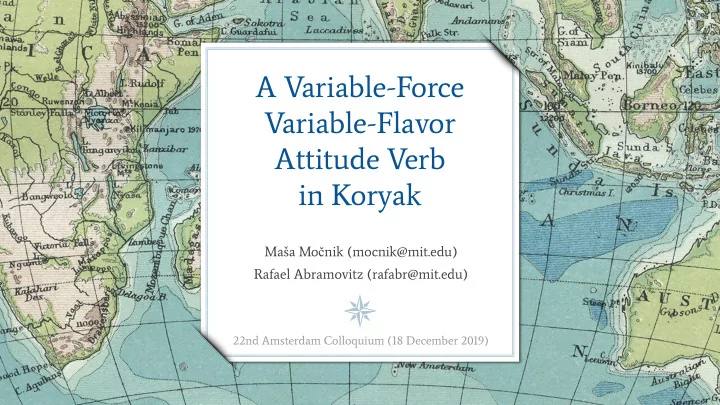

A Variable-Force Variable-Flavor Attitude Verb in Koryak Maša Mo č nik (mocnik@mit.edu) Rafael Abramovitz (rafabr@mit.edu) 22nd Amsterdam Colloquium (18 December 2019)
Roadmap ➢ Introduction ➢ Koryak 'iv ə k' and Methodology ➢ PART 1: Variable-Force, Doxastic Flavor ➢ PART 2: Assertive Flavor ➢ PART 3: Bouletic Flavor (Embedded Clause) ➢ Contributions
Are there restrictions on force and flavor variability? (No.)
Modal elements [...] either vary on the [flavor] axis and thus are polyfunctional in the original sense of expressing different types of modality or they vary on the [force] axis and can express possibility and necessity, but they cannot vary on both axes. (Nauze 2008: 222) Bochnak (2015): not for modals us: not for propositional attitude verbs
Koryak Koryak (Chukotko-Kamchatkan family) ➢ verb "iv ə k" (infinitival form), "iv-" (root) ex. (2)-(3) ➢ assertive ('say') → doxastic ('think', 'allow for the possibility') → bouletic ('wish', 'hope', 'fear') → directive ('tell/order', 'propose/suggest') see App. →
Elicitation Methodology difficulty with contextual felicity judgments ➢ speakers often treat them as (syntactic) well-formedness → judgments solved with matching task ➢ → Russian dopuskat' ("to allow for the possibility", cf. Slovenian dopuščati in Močnik 2019)
Part 1 Variable Force & Doxastic Flavor preference for a strong interpretation ex. (4)-(5) ➢ (also in elicitations) weak reading available: ➢ ✓ IV p ∧ IV ¬ p ex. (6)-(8a) not with every doxastic verb: ➢ ✗ L Ə MALAV p ∧ L Ə MALAV ¬ p ex. (8b) we don't know if there are variable-force versions of the other flavors, ➢ e.g. existential 'say'
Part 1 Variable Force & Doxastic Flavor downward-entailing contexts: ex. (9)-(10) ➢ both readings seem available under negation: ➢ ¬ IV white ∧ ¬ IV black ex. (11) ♢ black ∧ ♢ white [negation+necessity vs possibility+neg-raising] → a speaker suggested that it can also express another thought (white+black), → if this is a separate reading, it would be accounted with: ⃞ black ∧ ⃞ white
Part 1 How to derive variable force? Rullmann et al. (universal quantification + restriction): Our version (following a suggestion by R. Schwarzschild) is essentially the same:
Part 1 iv p ∧ iv ¬p ex. (8b) belief state ✓ if g(C) is the set of all subset ¬ p p functions on the belief state
Part 1 ¬iv p ∧ ¬iv ¬p ex. (11b) belief state ✓ if g(C) is the set of identity • ¬ p functions on the belief state • p
Part 2 Assertive Flavor modal flavor of modals: ➢ underspecification (Kratzer 1977, 1981, 1991,...) vs polysemy (Nauze 2008, Viebahn & Vetter 2016,...) not what Nauze's generalization hinges upon ➢ we'll model it as underspecification ➢ specifiers: 'openly', 'with words', 'secretly', 'to oneself' →
Part 2 Assertive Flavor ✗ The teacher iv 'ed that his students studied well, ex. (16) but he iv 'ed that they studied badly. ✓ The teacher iv 'ed that his students studied well, but to himself he iv 'ed that they studied badly. ✓ The teacher iv 'ed that his students studied badly, but openly he iv 'ed that they studied well.
Part 2 Free (modal-base-like) variable at LF
Part 3 Bouletic Flavor: Embedded Clause bouletic flavor not found in the nominalization ex. (19) ➢ embedded conjunctions test (cf. Bogal-Allbritten 2016): ➢ iv [p,q] : ✓ think p and hope q ex. → (20) ✓ hope p but allow q ex. (21) ✗ say p and think q ex. (22) iv [p, would q]: think p and wish q ex. (23) →
Part 3 Bouletic Flavor: Embedded Clause group attitude holder test (cf. Bogal-Allbritten 2016): ➢ no hope/fear distinction ex. (24) → we have not yet found: ➢ a mixed-feelings flavor → a fear-version of wish ('I iv ə k that I was sad' would presuppose that I am → happy and assert that being sad is dis preferable)
Part 3 Bouletic Flavor: Illustration with wish Example denotation for 'wish' from the literature: ! belief-state contingent the goal is to abstract this out
Part 3 Bouletic Flavor: Illustration with wish Yalcin (2007): Example: iv ə k feeds here: Example: this in the world from which a restricted state? the way the info the info state is agent state is generated generated
Part 3 Bouletic Flavor: Illustration with wish Example denotation for 'wish' from the literature: issue: belief-state contingent the goal is to abstract this out
Part 3 Bouletic Flavor wish = iv ə k DOX + CF ➢ (most likely, it's actually CF+something covert) hope = fear = iv ə k DOX + a covert item downstairs ➢
Contributions methodological: ➢ solution for doing semantic fieldwork when contextual felicity → judgments fail empirical: ➢ variable-force attitude verb → variable-force-variable-flavor attitude verb (against the universal) → theoretical: ➢ bouletic meaning composed at LF → (doxastic quantifier + preference component)
Recommend
More recommend